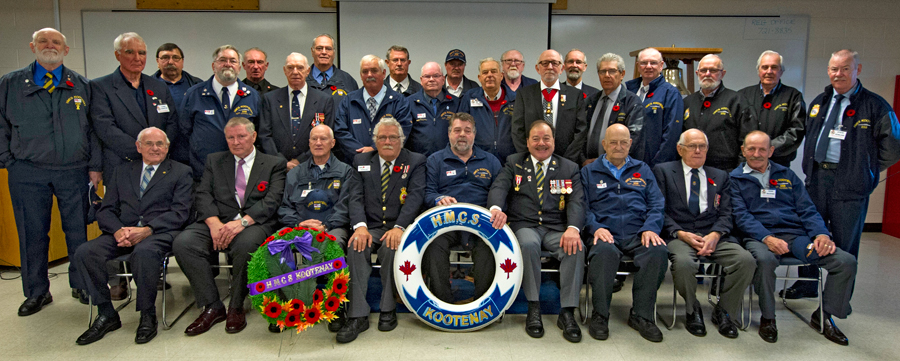HMCS Kootenay, 48 years after the explosion
By Lookout on Nov 29, 2017 with Comments 1

The surviving crew members of HMCS Kootenay pose for a group photo during the Commemorative Ceremony held at Damage Control Training Facility Kootenay on Oct. 23. Photo by LS Trent Galbraith, Formation Imaging Service
Ryan Melanson, Trident Staff ~
Former crewmembers of HMCS Kootenay, along with family, friends, and Royal Canadian Navy (RCN) personnel, gathered at Damage Control Training Facility (DCTF) Kootenay at CFB Halifax on Oct. 23 to mark 48 years to the day since the tragic explosion on the ship that killed nine sailors and wounded many more.
It was just after 8 a.m. on Oct. 23, 1969, as Kootenay was traversing the English Channel with a task group on the way back to Canada, when a full-speed engine trial led to the starboard gearbox overheating and exploding, filling the engine room and beyond with fire, oil and toxic smoke.
In addition to the nine who perished, seven instantly and two more as a result of smoke inhalation soon after, 53 crewmembers were injured, many developing lifelong chronic issues.
The explosion is considered the worst peacetime disaster in RCN history, and the story is well known both for the extraordinary efforts and sacrifices of the crew, as well as for the myriad advancements in safety and damage control that were spawned in its aftermath.
For the surviving crew, many of whom attended the ceremony in Purcell’s Cove, the weight of the tragedy is still felt, and some still have difficulty talking about the traumatic events that took place on the ship.
Patty Robichaud said her father Rob Robichaud, who died in 2014, never spoke about the events on board Kootenay when she was growing up. He didn’t open up to his family about his role in the disaster until much later in life, when his granddaughter approached him for help with a school history project. It led to an emotional discovery of her father’s harrowing story, she said, and a better understanding of things such as the strict upbringing she and her siblings had as children.
“As I now realize, he did not want us to ever be put in a situation like the one he survived. He had seen the worst, and he was willing to do anything he could to protect us from harm and hurt in our lives,” she wrote in an address prepared for the ceremony.
Robichaud wasn’t able to attend due to medical reasons, and her words were read by Cyril Johnston, whose father was a Sub-Lieutenant in Kootenay in 1969. The two were together with other officers Clark Reiffenstein and John Montague when the gearbox blew, and all of them courageously ventured back into the black smoke after escaping to safety to look for other shipmates.
The trauma of the incident has caused some of the crew to suffer through the effects of PTSD, and while some now receive therapy and other forms of support, the impacts weren’t widely understood in the 1970s and 80s.
“At 19 years old, my father had to endure a pain and suffering that most of society hopefully never has to endure,” she wrote.
Capt(N) Paul Forget, Base Commander CFB Halifax, said the officers and non-commission members who serve today have all been shaped by the damage control instructions that were formed from lessons learned in the Kootenay explosion, and that sailors should feel a direct link between their training and the experiences of the former sailors who filled the room at the damage control facility on Oct. 23.
“We’re all mesmerized by the stories of tragedy below decks, and the ingenuity and courage that was required to minimize loss of life and save the ship,” Capt(N) Forget said.
Cdr Pete Lebel, the Commandant of Naval Fleet School Atlantic, which includes DCTF Kootenay, said the 1969 explosion led to better training, more thorough inspection schedules, and more firefighting equipment on board ships, which is housed in multiple strategic locations. Ship designs have also been modified to better plan for similar incidents, including the engine-room escape hatch on some ships, known as the “Kootenay Hatch”.
“You can rest assured that we’ve learned from Kootenay and we continue to learn from it, and we’re making our environments better and safer as we move forward,” Cdr Lebel said.
Members of HMCS Kootenay who died Oct. 23, 1969:
CPO1 Vaino ‘Ski’ Partanen
CPO2 William Alfred ‘Billy’ Boudreau
PO Eric George Harman
PO Lewis John Stringer
LS Pierre ‘Pete’ Bourrett
LS Thomas Gordon Crabbe
LS Gary Wayne Hutton
OS Michael Allen Hardy
OS Nelson Murray Galloway
Filed Under: Top Stories
About the Author:






Dear Sir/Madam,
Reading the account of the tragic explosion/fire on board HMCS Kootenay in 1969,
brought back my own vivid memories of this horrific incident.
I was a mechanical Fitter directly involved in the essential work required on the Ship when She was towed into Devonport Royal Dockyard at Plymouth UK.
I worked on the removal of the propellers when the ship was in dry-dock, and then on the investigative dismantling of the drive trains and gearbox bearings etc.
At the time, I made some detailed technical notes that would be directly linked to the causes of the explosion and fire, which I am sure would be of much interest to both the surviving Ships Staff and anyone who has studied and followed this catastrophy.
I would be happy to submit these technical details to the appropriate body, if required,
Yours Sincerely Robert Twitchin.